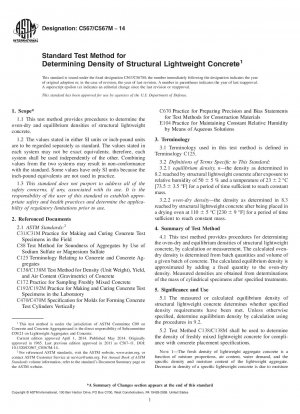ASTM C567/C567M-14
Standard Test Method for Determining Density of Structural Lightweight Concrete
- Standard No.
- ASTM C567/C567M-14
- Release Date
- 2014
- Published By
- American Society for Testing and Materials (ASTM)
- Status
- Replace By
- ASTM C567/C567M-19
- Latest
- ASTM C567/C567M-19
- Scope
5.1 The measured or calculated equilibrium density of structural lightweight concrete determines whether specified density requirements have been met. Unless otherwise specified, determine equilibrium density by calculation using the procedures in 9.2.
5.2 Test Method C138/C138M shall be used to determine the density of freshly mixed lightweight concrete for compliance with concrete placement specifications.
Note 1—The fresh density of lightweight aggregate concrete is a function of mixture proportions, air content, water demand, and the specific density and moisture content of the lightweight aggregate. Decrease in density of a specific lightweight concrete is due to moisture loss that, in turn, is a function of aggregate moisture content, ambient conditions, and the ratio of the surface area to the volume of the concrete member. For most structural lightweight concretes, equilibrium density is approached at about 90 days. For most high-strength lightweight concretes, equilibrium density is approached at about 180 days. Extensive tests demonstrate that despite variations in the initial moisture content of lightweight aggregate, the equilibrium density will be approximately 50 kg/m3 [3.0 lb/ft3] greater than the oven-dry density.1.1 This test method provides procedures to determine the oven-dry and equilibrium densities of structural lightweight concrete.
1.2 The values stated in either SI units or inch-pound units are to be regarded separately as standard. The values stated in each system may not be exact equivalents; therefore, each system shall be used independently of the other. Combining values from the two systems may result in non-conformance with the standard. Some values have only SI units because the inch-pound equivalents are not used in practice.
1.3 This standard does not purport to address all of the safety concerns, if any, associated with its use. It is the responsibility of the user of this standard to establish appropriate safety and health practices and determine the applicability of regulatory limitations prior to use.
ASTM C567/C567M-14 Referenced Document
- ASTM C125 Standard Terminology Relating to Concrete and Concrete Aggregates
- ASTM C138/C138M Standard Test Method for Density (Unit Weight), Yield, and Air Content (Gravimetric) of Concrete
- ASTM C172 Standard Practice for Sampling Freshly Mixed Concrete
- ASTM C192/C192M Standard Practice for Making and Curing Concrete Test Specimens in the Laboratory
- ASTM C31/C31M Standard Practice for Making and Curing Concrete Test Specimens in the Field
- ASTM C470/C470M Standard Specification for Molds for Forming Concrete Test Cylinders Vertically
- ASTM C670 Standard Practice for Preparing Precision and Bias Statements for Test Methods for Construction Materials
- ASTM C88 Standard Test Method for Soundness of Aggregates by Use of Sodium Sulfate or Magnesium Sulfate
- ASTM E104 Standard Practice for Maintaining Constant Relative Humidity by Means of Aqueous Solutions
ASTM C567/C567M-14 history
- 2019 ASTM C567/C567M-19 Standard Test Method for Determining Density of Structural Lightweight Concrete
- 2014 ASTM C567/C567M-14 Standard Test Method for Determining Density of Structural Lightweight Concrete
- 2011 ASTM C567/C567M-11 Standard Test Method for Determining Density of Structural Lightweight Concrete
- 2005 ASTM C567-05a Standard Test Method for Determining Density of Structural Lightweight Concrete
- 2005 ASTM C567-05 Standard Test Method for Determining Density of Structural Lightweight Concrete
- 2004 ASTM C567-04 Standard Test Method for Determining Density of Structural Lightweight Concrete
- 2000 ASTM C567-00 Standard Test Method for Determining Density of Structural Lightweight Concrete
